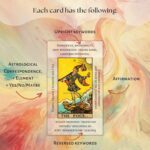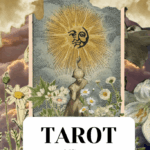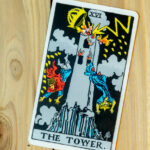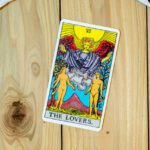Tarot cards have fascinated people for centuries, serving as tools for divination, self-reflection, and guidance. Their origins are rooted in the 15th century, where they began as a parlor game in Europe. As time progressed, these cards evolved into a profound means of accessing spiritual insights. This article delves into the intricacies of tarot cards and their meanings, exploring various facets such as the structure of the deck, specific card interpretations, as well as the broader implications of a tarot reading.
The tarot deck consists of 78 cards, which are categorized into two main groups: the Major Arcana and the Minor Arcana. The Major Arcana comprises 22 cards that embody significant life themes and spiritual lessons. Each card in this subset stands alone with unique symbolism, encapsulating archetypal energies that resonate with profound life experiences. Examples of these pivotal cards include The Fool, representing new beginnings, and The World, symbolizing completion and accomplishment. These cards often serve as the focal point in a reading, marking pivotal periods of personal growth.
In contrast, the Minor Arcana consists of 56 cards divided into four suits: Wands, Cups, Swords, and Pentacles. Each suit corresponds to different spheres of life. Wands are often associated with creativity and action, Cups deal with emotions and relationships, Swords represent intellect and conflict, while Pentacles signify material aspects, including finances and career. Within each suit, the cards range from Ace to Ten, along with four court cards—Page, Knight, Queen, and King—each delineating varying levels of maturity and energy.
When delving into the meanings behind the cards, it is essential to consider the symbolism and imagery encapsulated within each individual card. For instance, the imagery on The Tower card reflects chaos and sudden change, emphasizing the necessity of upheaval for reconstruction and renewal. Conversely, The Sun card radiates positivity, illuminating themes of joy, success, and vitality. Understanding these symbols enables readers to interpret the nuances of a card’s meaning more effectively during a reading.
Moreover, the context in which the cards are drawn plays a crucial role in interpretation. Each card’s significance can shift dramatically depending on its position in a spread and its relationship to adjacent cards. A common spread is the three-card spread, which typically signifies the past, present, and future. In this spread, a card representing past influences may shed light on the present situation and guide predictions for future outcomes. Thus, a reader must engage in a holistic view when accessing the cards’ meanings, considering both individual symbols and their interconnectedness within the reading’s narrative.
The art of tarot reading extends beyond the mere extraction and interpretation of cards; it encompasses an entire methodology aimed at fostering connection, introspection, and discovery. Tarot is often utilized in personal growth practices, where individuals seek clarity and insights into their lives. This form of exploration empowers one to delve into personal dilemmas, helping to illuminate the path forward. With its empathetic guidance, tarot serves as a mirror, reflecting the seeker’s inner thoughts and emotions.
Additionally, tarot’s utility is not confined solely to personal inquiry; it can be employed in professional settings as well. Many therapists and life coaches incorporate tarot readings as a complement to traditional therapeutic modalities. By using tarot to prompt dialogue and introspection, counselors can facilitate a deeper understanding of their clients’ emotional landscapes. This integrative approach to well-being underscores the adaptability of tarot across various life domains.
As you embark on your journey into the world of tarot, you may encounter an array of resources designed to deepen your understanding. Tarot books, such as “Tarot Decoded: A Beginner’s Guide to Tarot Card Meanings,” offer in-depth explorations of card interpretations, historical contexts, and practical tips on how to conduct readings. Many of these texts provide evocative illustrations and succinct explanations, which can significantly enhance the learning experience for novices and seasoned practitioners alike.
Moreover, online platforms have burgeoned, providing a plethora of tutorials, articles, and forums where enthusiasts can share insights and experiences. Engaging with such communities often cultivates a supportive environment where individuals can develop their skills and exchange ideas without fear of judgment. These resources not only enrich one’s tarot knowledge but also foster bonds among those united by a shared interest in this arcane practice.
Engaging with tarot can also lead one to explore related divination practices, such as oracle cards, runes, or astrology, broadening the horizons of spiritual inquiry. Each practice brings unique perspectives and methodologies, enriching the overall experience of seeking guidance. The cross-pollination of these various systems can unveil deeper truths, providing a more comprehensive understanding of the forces at play in one’s life.
Ultimately, tarot cards are intricate tools that transcend mere fortune-telling. They serve as portals to introspection, self-knowledge, and enlightenment. Their meanings, steeped in symbolism and history, can reveal profound insights when approached with an open heart and mind. Whether you are a novice seeking guidance or a seasoned reader honing your craft, embracing the journey through the tarot can unearth myriad dimensions of understanding, illuminating the path to your innermost self.









Leave a Comment